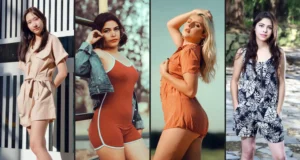Indecent dressing is a complex issue in society today. As cultures change, deciding what is inappropriate clothing is very subjective. As we enter 2024, looking carefully at indecent dressing is crucial.
Defining Indecent Dressing
Some key factors that make clothing indecent include:
- How revealing the clothes are – Cropped tops, mini skirts, and see-through fabrics can cross the line.
- How tight or clingy the outfit is – Extremely tight, form-fitting clothes push decency limits.
- If images/text are sexually explicit – Graphic prints quickly become indecent.
- If private body parts are exposed or strongly shown off – Underwear worn openly is often seen as inappropriate.
Of course, views depend on cultural norms, age, gender, and setting. A swimsuit at the beach may be fine. That same swimsuit in a classroom would likely be seen as indecent.

Social Media’s Influence on Provocative Fashion
Trends on social media greatly affect mainstream fashion, sometimes shifting standards toward more revealing clothes. The constant flood of risqué outfits online can distort what people see as appropriate in public. Some use sexy dressing on social media for attention and approval, impacting mental health and body image.
The rules platforms put around indecent content will likely influence related dressing habits. As social media changes, so will its connection to sexy fashion.
Concerns Around Increasingly Revealing Attire
Major concerns about the increase in indecent dressing include:
- More sexual harassment, like catcalling, groping, or advances.
- More frequent objectification and loss of respect when seen sexually.
- Unfair judgments of character based on clothes.
- Limits on self-expression to avoid excess attention.
- Safety risks in certain environments.
Revealing clothes often draw unwanted looks and remarks. They also lead to false assumptions about identity. Finding an appropriate balance remains important.
Promoting Decency Through Open Dialogue
To encourage decency in how people dress, helpful approaches include:
- Dressing appropriately for the age, culture, and setting.
- Finding a personal balance between style and modesty.
- Modeling positive clothing choices.
- Kindly educate on potential impacts.
- Respecting preferences while upholding standards.
With empathy and talks, we can set reasonable expectations around decency that consider different perspectives. Progress takes time but can occur through understanding.
The Intricate Psychology Behind Provocative Dressing
Complex psychological factors often motivate indecent dressing, such as:
- Seeking validation or sexual attention.
- Testing boundaries and rebelling.
- Asserting independence through appearance.
- Coping mechanism related to trauma or self-esteem.
Because motivations are nuanced, meeting provocative dressing with compassion is key. Grasping the root causes allows for more effective solutions.
Legal Implications of Indecent Attire
While indecent dressing raises social concerns, legal problems can also occur, especially around public attire and workplace dress codes. Navigating decency laws and clothing choice rights requires careful thinking about many factors. There are rarely simple universal answers.
As ideas of decency change, our approaches must be thoughtful, caring, and open-minded. This will allow fashion to make people feel happy, confident, and safe without marginalization or limits. The future requires accepting nuance.
Disadvantages of Indecent Dressing
Indecent dressing can put people in uncomfortable or even dangerous situations. While everyone can wear what they want, clothes do communicate messages, whether intended or not. Revealing attire often draws unwanted attention and has many disadvantages.
- Increased risk of sexual harassment and assault
- Increased risk of violence and victim blaming
- Loss of respect
- Discrimination
- Self-esteem problems
- Increased risk of accidents
- Discomfort
In summary, provocative dressing has social, psychological, and physical negatives. While free to make fashion choices, we should consider how our clothes impact ourselves and others.
Increased Risk of Sexual Harassment
- Wearing provocative clothing makes people more vulnerable to harassment like catcalling, leering, groping, and sexual propositions.
- Predators see scantily dressed individuals as easier targets.
- Victims are never to blame, but prudent dressing may help avoid unwanted advances.
Increased Risk of Violence
- Indecent dressing can provoke anger and violence in some people.
- Attackers often justify assault by saying victims “asked for it” based on their clothes.
- While unfair, provocative styles can act as a trigger or perceived invitation for would-be criminals.
Loss of Respect
- Revealing clothes may be seen as a sign of low self-respect or disrespect for others.
- People who dress indecently can be viewed as poor role models.
- In many contexts, modesty is still expected, and revealing attire is offensive to some.
Discrimination
- Indecent dressing can lead to bias in employment, education, housing, etc.
- Provocative clothes may be perceived as lazy, unintelligent, or morally loose.
- Job candidates, students, and tenants face barriers when their style works against them.
Self-Esteem Issues
- Indecent dressing leads to constant judgment and comparison, especially for youth.
- Young people can tie self-worth too closely to perceived sex appeal.
- This causes body image issues, shame, anxiety, and poor self-esteem.
Increased Risk of Accidents
- Revealing clothes are prone to wardrobe malfunctions and mobility issues.
- Tight skirts, plunging necklines, and high heels can lead to trips and falls.
- Hazards like loose straps, dragging hemlines, and impaired movement abound.
Discomfort
- Indecent styles sacrifice comfort, particularly in hot climates.
- Form-fitting and revealing clothing is often impractical.
- Freedom of movement, privacy, and protection from elements is reduced.
In summary, provocative dressing has social, psychological, and physical downsides. While free to make our own fashion choices, we should be mindful of how our clothing impacts ourselves and others.

The Connection to Sexual Harassment
Indecent dressing is sometimes linked to increased risks of sexual harassment, like catcalling, groping, or unwanted advances. However, harassment is always the fault of the perpetrator – no clothing justifies assault.
Victim Blaming Must Stop
Victim blaming and the notion that provocative dress invites harassment is problematic thinking. Only respect and consent matter.
Society Must Progress
As a society, we must progress beyond shaming victims and clarify that harassment is never excusable, regardless of attire. The responsibility is always on the perpetrator.
Education and Empathy Are Keys
Moving forward requires education on respect, consent, and empathy. With compassion and understanding, we can address harassment and empower people to express themselves through fashion.
Restoring Decency in How We Dress
While notions of decency continuously evolve, there are positive approaches we can take to encourage modesty and respect in clothing choices.
Dress Appropriately for the Situation
Considering the occasion, setting, age, and cultural context can help guide what is considered decent attire. What is appropriate for the beach may not be suitable for the office. Dressing with the environment in mind shows respect.
Find a Personal Balance
No one should feel forced to dress in a way that makes them uncomfortable. Finding a personal balance between self-expression and social appropriateness is key.
Lead by Example
We can inspire decency in others through our own clothing choices. Serving as a role model and dressing appropriately for each occasion makes a difference.
Education Promotes Understanding
Education is crucial for combating indecent dressing and cultivating mutual understanding.
Comprehensive Sex Education Matters
Sex education covering respect, consent, and healthy relationships helps young people make informed choices.
Teach Cultural Sensitivity
Understanding diverse cultural values around modesty promotes sensitivity. Open discussion and avoiding judgment are key.
Parents Play a Role Too
Parents can have crucial conversations with kids about decency, self-image, and making smart clothing choices. Learning begins at home.
We can thoughtfully shape social norms around decency with compassion and meaningful dialogue. The path forward requires patience, empathy, and rejection of hurtful shame.
The Psychology of Indecent Dressing
There are often complex psychological factors that influence provocative dressing choices.
Clothing and Self-Image
Fashion can play a strong role in self-image and confidence. Revealing styles can help some feel sexy and empowered. For others, it can negatively impact body image and self-esteem.
Social Conditioning Around Attire
Social conditioning shapes attitudes around appropriate attire from a young age. Media, family, peers, and cultural values all contribute to norms around decency. Pushing boundaries through provocative dress may be a reaction to this.
Fashion as Self-Expression
Clothing is a powerful means of self-expression and asserting identity. Revealing styles allow some to explore and celebrate their sexuality. For others, it provides an outlet for creativity and standing out.
The Economics of Provocative Clothing
Economic factors also play a role in trends around indecent dressing.
The High Costs of Fast Fashion
Many provocative clothing items are inexpensive, fueled by unsustainable fast fashion cycles. People on a budget may be more likely to buy these affordable, revealing outfits.
Environmental Impact
Fast fashion’s environmental toll is massive. As demand grows for extremely cheap, disposable, indecent clothes, sustainability suffers.
Clothing Choices and Social Messages
In some contexts, wearing expensive, branded, revealing clothing is seen as a status symbol and statement of social standing or lifestyle. The meaning conveyed by clothing choices is complex and highly personal.
In a world where social media accelerates clothing trends rapidly, the economics around provocative fashion will continue evolving in years to come.
The Role of Media in Promoting Decency
The media plays an influential role in shaping social norms around decency in attire.
Positive Representation Matters
Media can promote decency by featuring diverse role models dressing stylishly yet appropriately for each context. Exposure to modest fashion choices has an impact.
Advertising Shapes Trends
Ads selling provocative clothing contribute enormously to normalizing sheer and revealing styles. Responsible ad campaigns focused on elegance overexposure could help shift norms.
Combating Indecent Dressing
Media platforms and figures are responsible for thinking critically about the messaging and values conveyed around indecent dressing. Advocating for decency standards while rejecting body shaming is crucial.
Culture and Decency – Finding a Balance
Notions of decency are deeply intertwined with cultural values and traditions.
Culture Informs Decency
Cultural norms around modesty, gender roles, and sexuality greatly shape definitions of decency worldwide. What is acceptable in one culture may be taboo in another.
Respecting Diversity
Navigating diverse cultural values is complex. Being open-minded, avoiding judgment, and educating ourselves about various perspectives allows us to balance decency social norms with freedom of expression.
Change Takes Time
Cultural shifts happen incrementally. Pushing change too aggressively can marginalize traditions before understanding occurs. Patience and compassion for all viewpoints are essential.
Looking to the Future
As global fashion evolves, new complex questions around decency will emerge.
Sustainable, Ethical Fashion
Ethical, sustainable fashion growth could lessen reliance on cheaply made indecent garments and their social impacts.
Tech Innovation for Modesty
New technologies may help promote modest fashion, like innovative fabrics providing coverage and breathability.
Diversity and Inclusion
Fashion must welcome diversity in culture, gender, body type, age, and beliefs by expanding offerings to meet varied needs. Unity through understanding is the path forward.
With open minds and respect for all, we can build a thoughtful, inclusive future for fashion where decency is redefined based on acceptance, not restriction or judgment of others.

Summary
As concepts of decency continuously morph, we must thoughtfully shape an inclusive future where self-expression and respect coexist. Open minds, ongoing dialogue, and education can help us understand the diverse motivations behind provocative dressing without judgment.
Fashion choices are complex – balancing individuality, social norms, and safety requires compromise. But change is possible when we lead with empathy.
Decency will look different moving forward. But frameworks valuing compassion over shame can allow people everywhere to dress freely in ways that make them feel confident, comfortable, and respected.
With care, time, and willingness to hear all voices, we can build a fashion landscape focused not on restriction – but on acceptance, understanding, and celebrating our diverse human beauty.
FAQ
What is immodest clothing?
Immodest clothing refers to clothing that is considered to be revealing or sexually suggestive in nature. The exact definition may vary depending on cultural, religious, and personal beliefs. Generally, immodest clothing includes garments that expose too much skin, such as low-cut tops, short skirts or shorts, tight-fitting clothing, and clothing that does not cover certain body parts adequately.
What is indecent dressing in a woman?
Indecent dressing in a woman refers to clothing choices that are considered inappropriate, provocative, or offensive in a given cultural or societal context. The definition of indecent dressing can vary depending on cultural norms, religious beliefs, and personal values. It typically involves clothing that reveals too much skin, is excessively tight or revealing, or is sexually suggestive in nature.
Is indecent dressing a crime?
Indecent dressing is not typically considered a crime, but it can be subject to cultural, societal, or workplace norms and regulations. Dress codes can vary depending on the context, such as schools, workplaces, or public spaces. It is important to understand and adhere to the dress code guidelines set by the respective organizations or communities.
Does indecent exposure include breasts?
Yes, indecent exposure can include the exposure of breasts, depending on the specific laws and regulations of the jurisdiction in question.
What is inappropriate to wear in public?
It depends on cultural norms and specific contexts, but generally, it is considered inappropriate to wear revealing or offensive clothing in public. It is important to dress modestly and respectfully, taking into account the social norms and expectations of the community you are in.



